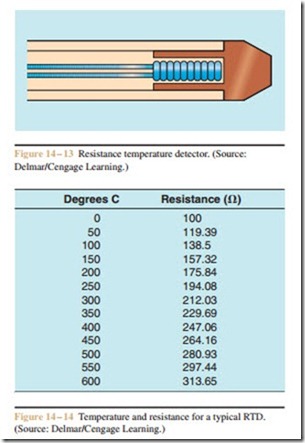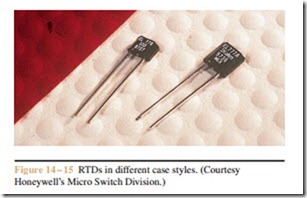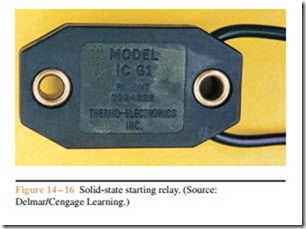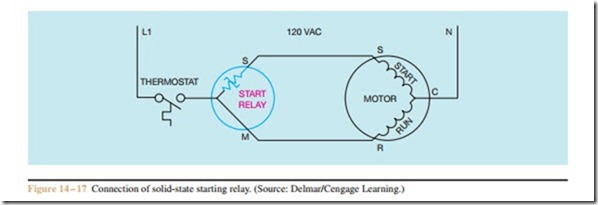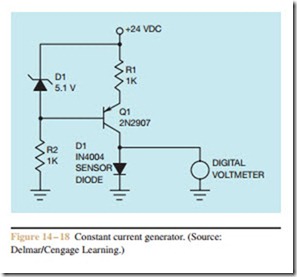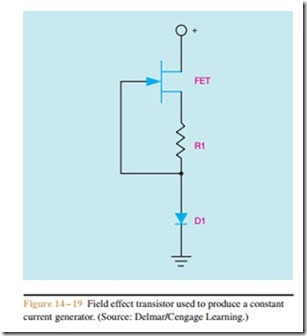Resistance Temperature Detectors
that holds a gas valve open and permits gas to flow to the main burner. If the pilot light should go out, the thermocouple ceases to produce current and the valve closes (Figure 14 – 12).
The resistance temperature detector (RTD) is made of platinum wire. The resistance of platinum changes greatly with temperature. When platinum is heated, its resistance increases at a very predictable rate; this makes the RTD an ideal device for measuring temperature very accurately. RTDs are used to measure tempera- tures that range from -328 to +1166 degrees Fahren- heit (-200 ° to +630°C ). RTDs are made in different styles to perform different functions. Figure 14 – 13 illustrates a typical RTD used as a probe. A very small coil of platinum wire is encased inside a copper tip. Copper is used to provide good thermal contact. This permits the probe to be very fast-acting. The chart in Figure 14 – 14 shows resistance versus temperature for a typical RTD probe. The temperature is given in degrees Celsius and the resistance is given in ohms. RTDs in two different case styles are shown in Figure 14 – 15.
Thermistors
The term thermistor is derived from the words “thermal resistor.” Thermistors are actually thermally sensitive semiconductor devices. There are two basic
types of thermistors: one type has a negative tempera- ture coefficient (NTC) and the other has a positive temperature coefficient (PTC). A thermistor that has a negative temperature coefficient will decrease its resistance as the temperature increases. A thermistor that has a positive temperature coefficient will increase its resistance as the temperature increases. The NTC thermistor is the most widely used.
Thermistors are highly nonlinear devices. For this reason they are difficult to use for measuring temperature. Devices that measure temperature with a thermistor must be calibrated for the particular type of thermistor being used. If the thermistor is ever replaced, it has to be an exact replacement or the circuit will no longer operate correctly. Because of their nonlinear characteristics, thermistors are often used as set point detectors as opposed to actual temperature measurement. A set point detector is a device that activates some process or circuit when the temperature reaches a certain level. For example, assume a thermistor has been temperature reaches a certain point, the resistance value of the thermistor changes enough to cause the starter coil to drop out and disconnect the motor from the line. Thermistors can be operated in temperatures that range from about -100 ° to +300°F.
One common use for thermistors is in the solid- state starting relays used with small refrigeration compressors (Figure 14 – 16). Starting relays are used with hermetically sealed motors to disconnect the start wind- ings from the circuit when the motor reaches about 75% of its full speed. Thermistors can be used for this application because they exhibit an extremely rapid change of resistance with a change of temperature. A schematic diagram showing the connection for a solid- state relay is shown in Figure 14 – 17.
When power is first applied to the circuit, the thermistor is cool and has a relatively low resistance.
This permits current to flow through both the start and run windings of the motor. The temperature of the thermistor increases because of the current flowing through it. The increase of temperature causes the resistance to change from a very low value of 3 or 4 ohms to several thousand ohms. This increase of resistance is very sudden and has the effect of opening a set of contacts connected in series with the start winding. Although the start winding is never completely disconnected from the power line, the amount of current flow through it is very small, typically 0.03 to 0.05 amperes, and does not affect the operation of the motor. This small amount of leakage current maintains the temperature of the thermistor and prevents it from returning to a low resistance. After power has been disconnected from the motor, a cool-down period of about 2 minutes should be allowed before restarting the motor. This cool-down period is needed for the thermistor to return to a low value of resistance.
The PN Junction
Another device that has the ability to measure current flow through the zener diode and the base of the transistor. D1 is a common silicon diode. It is being used as the temperature sensor for the circuit. If a digital voltmeter is connected across the diode, a voltage drop between 0.8 and 0 volts can be seen. The amount of voltage drop is determined by the temperature of the diode.
Another circuit that can be used as a constant current generator is shown in Figure 14 – 19. In this circuit, a field effect transistor (FET) is used to produce a current generator. Resistor R1 determines the amount of current that will flow through the diode. Diode D1 is the temperature sensor.
If the diode is subjected to a lower temperature, say by touching it with a piece of ice, the voltage drop across the diode will increase. If the diode temperature is increased, the voltage drop will decrease because the temperature is the PN junction, or diode. The diode is becoming a very popular device for measuring temperature because it is accurate and linear.
When a silicon diode is used as a temperature sensor, a constant current is passed through the diode. Figure 14 – 18 illustrates this type of circuit. In this circuit, resistor R1 limits the current flow through the
transistor and sensor diode. The value of R1 also deter- mines the amount of current that flows through the
In Figure 14 – 20, two diodes connected in a series are used to construct an electronic thermostat. Two diodes are used to increase the amount of voltage drop as the temperature changes. A field effect transistor and resistor are used to provide a constant current to the two diodes used as the heat sensor. An operational amplifier is used to turn a solid-state relay on or off as the temperature changes. In the example shown, the circuit will operate as a heating thermostat. The output of the amplifier will turn on when the temperature decreases sufficiently. The circuit can be converted to a cooling thermostat by reversing the connections of the invert- ing and noninverting inputs of the amplifier.

